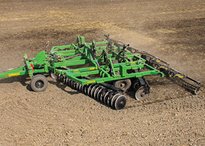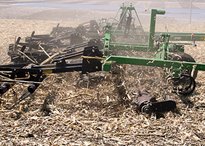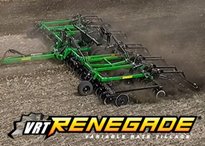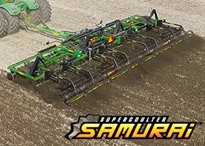Q&A with Summers Engineers
When it comes to land rollers, Summers has the competitive edge. Although some farmers treat land rollers as a commodity that can be purchased cheap and replaced every few years, the ones built to a high standard can withstand season after season of smashing down rocks, busting clods and preparing the seedbed. On the other hand, thin frames, small tires, shoddy welds and cumbersome brace supports are all signs that a company cut corners during design or manufacturing.

That’s one reason Summers went to such lengths to make itsSuperRollers the toughest available – aspects that Travis Westlind and Paul Wilhelmi can attest to. These Summers engineers have been closely involved with land rollers, as well as the improvements to the 2016 lineup. They farm, too, and practice what they preach. The Anvil sat down with them to talk about what sets SuperRollers apart.
Q: Before we get into the equipment itself, can you briefly explain what land rollers are primarily used for?
TRAVIS: Their greatest benefit is getting the field in as good a condition as possible for planting and harvest. It’s about creating a smooth, flat surface free of rocks, dirt clods, root balls and other debris. So a header can be as low as it needs to without fear of damage or excessive wear to it or a combine. They also increase seed-to-soil contact when used after planting, and research has shown land rollers actually boost yields in certain crops.
Q: So would you say land rollers are tools modern farmers should consider on their farm?
PAUL: Most definitely. At one time land rollers were somewhat of a novelty, but any reservations about them have all but disappeared as more and more farmers see results for themselves.
Q: Given the popularity of land rollers, it seems farmers have many options to choose from on the market. So what makes Summers SuperRollers different?
TRAVIS: Land rollers may be relatively simple pieces of equipment, but they work in some pretty harsh field conditions. SuperRollers are designed and built with features that may seem like overkill to some, but they help assure a long working life with minimal downtime.
Q: The frame seems especially heavy compared to some other models.
TRAVIS: Exactly. For us, it’s all about giving our producers a product that will enable them to cover the acres they need every single day. We know they appreciate the extra effort we put into building SuperRollers, as well as the fact that they have the highest residual resale values of any land roller on the market.
PAUL: Don’t forget about the drum walls. They’re much thicker than comparable land rollers, which help maintain the integrity of the drum after years of rolling, even in tough rocky conditions. Also, you need weight for effective rolling. Our philosophy is that we might as well put the weight into having heavy drum walls and heavy frames that will stand the test of time. Plus, they’re heavy enough to do the job, so adding water isn’t required.
Q: We noticed some land rollers use small rollers to cover the seams between the larger drums. Does this design cause any issues?
PAUL: Cosmetically, this approach may make the field look consistent; however, these smaller sections likely won’t have enough weight to push something like a large rock into the ground. Plus, having those small rollers adds a lot of unnecessary bearings and moving parts, which could mean more maintenance and potential downtime.
Q: So what design does Summers use instead?
TRAVIS: We design our SuperRollers to have complete coverage by staggering the rollers, which allows for just slight overlap. That way the field finish is consistent, and even large rocks can be pushed down without trouble.
Q: Has the demand on land rollers changed in recent years to warrant this “overbuilding” of SuperRollers?
TRAVIS: Well, farm sizes have definitely changed. They’ve been getting larger and larger, so producers need to cover more acres per day and have farther to travel from field to field than they used to.
Q: Is that why you put so much emphasis on the transport system?
PAUL: Precisely. As farms have grown, they’ve also become more spread out, so it’s not uncommon today for producers to have land 30, 40 or 50 miles away. The result is a lot more road travel for equipment. This is why we’ve gone to great lengths to ensure our land rollers have the most robust transport system on the market.
Q: Speaking about that, tell us a bit about the exciting enhancements to the 3- and 5-section 2016 model trail type SuperRollers.
TRAVIS: Well, it starts with the premium tires, which have increased in number to 12 on the 5-section and eight on 3-section rollers. We’ve also designed oscillating tandems for all transport wheel sets to ensure the tires stay on the road in varying road conditions, which is especially beneficial when traveling on roads or trails with sloped shoulders, crowns or ever-present potholes. Added to the attributes our land rollers are already known for, these enhancements will lead to better results and overall improved experiences for producers.




























 Hats, Diecast Models, Gloves and More!
Hats, Diecast Models, Gloves and More!
 Library
Library